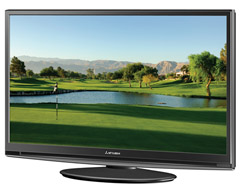Spring in New York is the time when the major television manufacturers take their last shot at impressing reviewers and critics with the latest TVs the companies plan to debut in late summer and early fall. In the last couple of weeks, I’ve squinted at new monitors from Westinghouse, Panasonic, Pioneer, and this week, Mitsubishi. So what is likely to be the next set you’ll buy?
 Westinghouse has made a name for itself—or rather re-introduced the name for itself—by offering relatively inexpensive but solidly built LCD-based, high-definition TVs. And it continues to apply price pressure on all the other companies. Within a few months it will offer, for example, a very sharp and very bright 52-inch LCD set, the TX-52F480S, for just $2,400 (list). That price may still sound high, but it will strike fear into the hearts of companies like Sony and Sharp; and it represents a good value (if you happen to have the money to spare). Westinghouse has made a name for itself—or rather re-introduced the name for itself—by offering relatively inexpensive but solidly built LCD-based, high-definition TVs. And it continues to apply price pressure on all the other companies. Within a few months it will offer, for example, a very sharp and very bright 52-inch LCD set, the TX-52F480S, for just $2,400 (list). That price may still sound high, but it will strike fear into the hearts of companies like Sony and Sharp; and it represents a good value (if you happen to have the money to spare).
At the other end of the scale, Pioneer continues to push the technical envelope in plasma HDTV sets. The company has improved the resolution—pushing it up to 1080p in some sets—and black levels and color fidelity of its models. However, Pioneer sets are still for the well-heeled, with the high-end HDTV 50-inch plasma models coming in at around $5,000 (now the Westinghouse model sounds cheap, doesn’t it?).
Meanwhile, Mitsubishi—once the king of large, traditional CRT sets—has moved from emphasizing rear-projection DLP-based TVs to underscoring its fleet of impressive flat-panel LCD monitors. On the DLP side, new features in some models will include a special 3-D gaming mode for connected computer games (yes, you’ll have to wear silly glasses). The effect is a little gimmicky, but gamers will appreciate it.
More impressive are Mitsubishi’s top-of-the-line LCD displays, which feature not only the hallmark of LCD sets—superior brightness—but also better motion and improved performance in dimly lit movie sequences (a.k.a., contrast ratios). The last two items are thanks to 120Hz image processing (which is twice the rate of standard 60Hz LCD sets) and dynamically adjusted brightness, which changes depending on the scene. Mitsubishi isn’t likely to threaten bargain builders, but its 144 Series 46-inch LCD monitor will list for just $3,899—and it delivers a stunning picture.
So what should shoppers look for this fall? Lower prices again, of course, with many of the numbers I’ve quoted falling further still. For what Panasonic is pushing, and for advice on how to choose between the competing HDTV technologies, see below.
J-Q.com |
